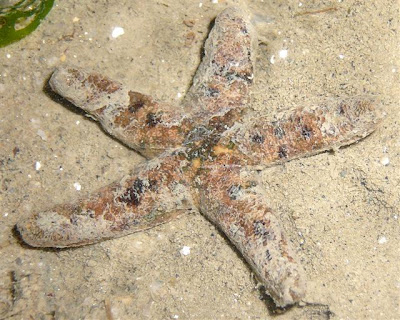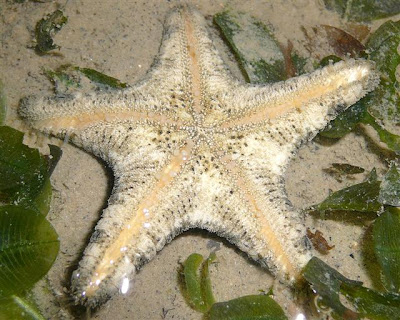Today's tide is the lowest for 2008 so am pretty excited yesterday night what marine treasures will be revealed. This morning at 5am, a small team of five of us arrived at Changi to hunt for my sand stars. To our amaze, we found more different types and numbers of sea stars than we expected today. There was a star concert at Changi with a total of eight possible different species found today!
When we first started, there were A LOT of biscuit-star-looking sea stars. These similar looking sea stars can either be juvenile cake sea stars (Anthenea aspera), biscuit sea stars (Goniodiscaster scaber) or Gymnanthenea laevis.
By the way, most of the sea star photos shown in this post will have its underside or the oral surface photographed. This is important for identification of sea stars and hopefully there's helpful people to id the photos here. :-)
This sea star could either be a juvenile cake sea star (Anthenea aspera) or Gymnanthenea laevis. My speculation will be the former.
And this is its oral surface. Both species have bivalved pedicellaria so I'm not too sure how to distinguish. Wish Dr Lane was there today.
Again, I am not sure if this is a juvenile cake sea star (Anthenea aspera) or Gymnanthenea laevis. My speculation will be the former as well.
This is the underside or the oral surface.

Yes, there are really many of these similar looking stars like the two featured above.

And this one shows similar oral surface features.
For this one, I am quite sure its a Gymnanthenea laevis sea star. Other than the orange tip which made me guess its identification, the more reliable check on the prominent spine-like tuberacles on the central radial plate on the upper surface tells me that this is a Gymnanthenea laevis.
Each plate of the oral surface of Gymnanthenea laevis sea star should be armed with a huge bivalved pedicellaria.
This is another sea star similar to the first few that I would like it should be Gymnanthenea laevis.

The oral surface of this particular sea star.

Otherwise, there are also PLENTY of biscuit sea stars (Goniodiscaster scaber) all around the intertidal area and this particular one is the biggest I've seen on our shores, with diameter of about 10cm or more.
The underside of the above huge biscuit sea star.
According to Dr Lane's "A Guide to Sea Stars and Other Echinoderms of Singapore", it was stated that the oral surface of biscuit sea stars (Goniodiscaster scaber) should be off-white, sometimes with purple pigmentation around the mouth and extending along either side of the ambulacral grooves.
Yes, the off-white and purple pigmentation is evident in some of the biscuit sea stars.

We also found many smaller biscuit sea stars as well :-)

The third sea star species to be found will be the cake sea stars (Anthenea aspera).
The team also found a stunning bright orange cake sea star (Anthenea aspera), that is still juvenile as compared to the large-sized adults.
And the oral surface is also orange-coloured as well.

This is a medium sized cake sea star that is cuter, with yellow tips on its arms.

The oral surface of the cake sea star shows scattered pedicellariae.

I guess the big surprise to me will be this adult-sized cake sea star that is as big as 15-20cm in diameter!!!
This sea star was really big and charismatic that it attracted much attention from my friends helping me to find sand stars.
We took some measurements and documentation of the many biscuit-looking sea stars and released them back. We were wondering where are the sand stars (Astropecten species).
As the tide goes out to the lowest possible of the day, more sea stars were revealed including this rare eight-armed sea star (Luidia maculata) found by Nicholas! Wow. They were only seen before at Chek Jawa, Pulau Sekudu and Beting Bronok. The very low tide today tells me that the deeper parts of Changi have other interesting and rarer species as well.

This is the oral surface of this eight armed sea star. One feature about
Luidia sea stars is that they have pointed tube feet without suckers so as to assist quick burrowing on soft substrates. They feed on small infaunal echinoderms and molluscs.

I was pleasantly surprised to find another Luidia sea star, this species I have never seen before! Ron and I suspect this is Luidia hardwicki . If it's true, it should be the first sighting intertidally.
Similar to the previous eight armed star, this sea star has pointed tube feet as well. What a great find!

Another big surprise will be this scaly sea star (
Nepanthia sp.) that I see it first time at our northern shores. This is possibly
Nepanthia belcheri. Acccording to Dr Lane's "Sea stars and echinoderms in Singapore BP guidebook", the upper or aboral surface of
Nepanthia belcheri has distinctive cresentic shape of the aboral plates which, with their convex edges appearing to overlap distally, somewhat resembling fish scales. This is true for this sea star.

The underside of this rare sea star is not brown but orange-red in colour. How nice :-)

Amongst the underneath of rocks, there exist yet another species of sea star and this is commonly known as the rock star (
Asterina coronata).
Finally this post will focused on two possible different species of the
Astropecten genus sand stars which is my main objective of today's recce trip to Changi.

This sand star that more patterns on the aboral surface and I highly suspect this is Astropecten vappa. Will wait for Dr Lane to arrive in Singapore soon to identify. Identification of Astropecten sea stars focuses mostly on the arrangement of its marginal spines.
Whereas, this sand star (Astropecten indicus) is the main character of my honours project. We found quite a number of them around the intertidal area.
I was asking the question to Dr Tan Koh Siang of TMSI whether these sand star eat the Asian date mussels (Musculista senhousia) which many of the mussel beds are found at Chek Jawa. Finally, I sort of got the answer during the recce as I noticed many many more sand stars are concentrated on the mussel beds themselves. I believe they are feeding on these mussels.
This is how the asian date mussel look like. Yet another question arose which is whether the small sand stars can tackle the mussels or not given their small sizes.
A quick check of the individual mussel reveal that these mussels at Changi are about 5-8mm in length only, smaller than the 20mm ones at Chek Jawa. The small sizes of the mussels might explain why the sand stars are feeding on the mussel beds at Changi. Am looking forward to study more on their relationships.

I'm glad to have my friends today to help me! Here is Geraldine and Shuyi. Also helping me are Nicholas and Xiuli. Xiuli is super photo-shy teehee.
Thank you for being there at super early timing :-)
Today was really star-studded. We also saw many different other stuffs, which I will blog about in another post. Do look out of it.









































No comments:
Post a Comment